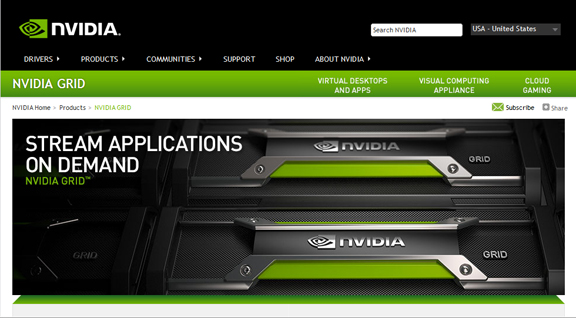Latest News
November 6, 2013
Graphics-heavy 3D programs once inseparably tied to powerful desktops are migrating. They’re heading into the cloud. More and more are making their debut as SaaS offerings. Today’s announcement from Amazon Web Services (AWS) and NVIDIA is further proof that cloud-hosted CAD is not merely speculative or conceptual; it’s already here, waiting in your browser.
For the past several years, NVIDIA has pursued, quite successfully, the high-performance computing (HPC) market by pitching its GPU clusters as an alternative to traditional clusters. Most recently, it unveiled the NVIDIA GRID VCA (visual computing appliance), a box preconfigured to function as a cluster.
This week, the GPU maker announces that AWS, Amazon’s scalable infrastructure that houses a majority of SaaS products, will begin offering GPU-based acceleration (dubbed G2) powered by the NVIDIA Grid.
“AWS sees a growing benefit for adding GPUs to our cloud,” said Matt Wood, general manager of Data Science at AWS. “The NVIDIA GRID GPUs in our new G2 instances enable graphical applications to be rendered in the AWS cloud and streamed to a world with increasing internet bandwidth and proliferation of device types.”
The NVIDIA Grid has been deployed to power cloud-hosted games, or game streaming. 3D games often have graphics requirements comparable to (or higher than) mechanical and architectural CAD programs.
A working example of this setup for 3D design software can be seen in Autodesk Remote, which lets you run Autodesk 3sx Max, Maya, Revit, and Inventor from mobile devices. (Read my colleague Beth Stackpole’s blog post, “Autodesk Readies Browser-Based CAD Products.”)
Average CAD or CAE users most likely won’t come in contact directly with AWS’s G2. But they certainly stand to benefit from it. G2 is expected to let software developers offer graphics-rich applications—those involving real-time ray-tracing or simulation, for instance—as SaaS.
In its early incarnations, SaaS offerings were largely lightweight programs. They confined themselves to data-management, collaboration, and annotation—operations that didn’t involve large-volume graphics visualization. Streaming graphics-rich CAD or CAE (computer-aided engineering) programs from a browser was not practical in the past, partly because of internet bandwidth limitations, partly because it was not possible to virtualize the GPUs. But NVIDIA changed that with the introduction of Kepler architecture in 2012.
In the past, you had no other choice but to use your professional 3D design and simulation programs from your desktop. But today’s cloud streaming technologies—like NVIDIA Grid and AWS G2—let you access your desktop software remotely from a tablet or a phone, just like you might bypass the DVD player and directly stream a movie from Netflix to your TV.
Subscribe to our FREE magazine, FREE email newsletters or both!
Latest News
About the Author
Kenneth Wong is Digital Engineering’s resident blogger and senior editor. Email him at [email protected] or share your thoughts on this article at digitaleng.news/facebook.
Follow DE






